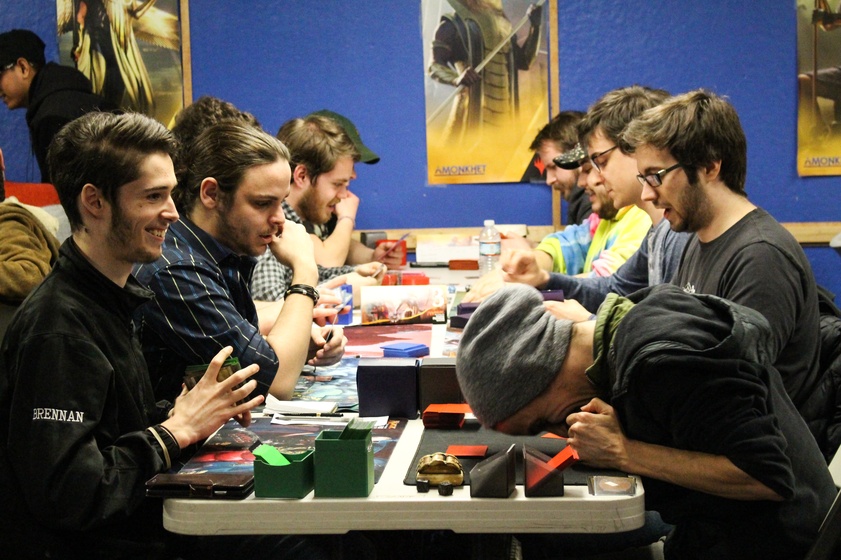The first floor of Pandemonium Books and Games is mostly a bookstore, full of titles ranging from Angus Watson’s “You Die When You Die” to “Star Wars” Mad Libs. The register is guarded by several plaster statues of mounted dragon heads, and the glass counter is full of individually tagged and packaged Magic cards, some of which cost more than I get paid in a month. A sign next to the stairs to the basement reads, “Please refrain from using strong language. Offenders may be exiled to Mordor.”
Every Friday night, Pandemonium hosts four different events where gamers gather to play Magic: The Gathering. To call Magic a card game doesn’t do it justice: Over the years, it has come to encompass novels, comics, tournaments, and a literal stock market. It’s here that I—what one of the gamers here might call “a complete noob”—find myself immersed in a culture that has been going strong since Magic was released in 1993.
“It’s just addictive, it’s fun, it’s relatable,” Abdul S. Ibrahim says. “There’s just a huge culture around it and we’ve all been playing it since we were kids.” He has been involved with Magic on and off for over 20 years—since he was five.
Ibrahim plays seriously. He goes to different Magic venues several times a week. Eric C. Bartolotti, on the other hand, plays only once or twice a month, but he’s still immersed in the culture. Bartolotti has been playing since he was in elementary school.
“My friends were all playing Magic, and it was the mature alternative to Pokemon at the time, so that made us feel all grown up,” he says. “Everyone around us was playing Pokemon and we were like, ‘No, no, Magic is the big boys’ thing.’”
This year marks the 25th anniversary of Magic: The Gathering, and the game has grown up along with many of its players. “There’s a lot more organization now,” Ibrahim says. “One nice thing is that there’s a lot more diversity now, which I appreciate. Even just the Magic: The Gathering plot—there are queer characters now, there are nonbinary characters now. They’ve taken huge strides.”
Downstairs is where the Magic happens. Over 100 players cram into the basement between shelves of role-playing games, art supplies and booster packs. It costs $5 to enter, and a few lucky winners get prizes in store credit, which they often use to buy more Magic cards. Magic is a self-perpetuating economy.
While some players don’t dedicate much time to the game, many invest money: Even casual players can rack up thousands of dollars worth of cards. “I spend more than I should for how little I play,” says Lia M. Thelen, who started playing Magic in college with her partner Zak G. Terry. “We have a box that’s supposed to be for 2,500 cards. I haven’t put the cards in the box yet, but I think it would at least be half full.”
Cards vary in price depending on supply and demand, according to Ibrahim. He and Bartolotti are flipping through card binders and point out some of the more expensive cards in the glass cases below us, ranging from a $2 Urza’s Mine to a $360 Sorcery.
Ibrahim names the Black Lotus as one of the most expensive cards. “Even people that don’t play Magic will be able to name off a Black Lotus,” he says. “A pack-fresh Black Lotus would probably be about $30,000.”
There’s even a Magic stock market. At mtgstocks.com, players can monitor card prices based on availability and popularity. Most people aim to buy rather than sell, but selling the right thing at the right time could help you get ahead on your rent for the month. “I know all those things in the ’90s that you could invest in, like Beanie Babies, Tickle Me Elmos, Pogs,” Bartolotti says. “If you could get your hands on the first couple sets they released—anyone who held onto that made a lot of money.”
These high stakes are part of the game’s appeal. “There’s this game in Magic that’s kind of notorious called Rip It or Flip It, where you’ll buy a booster pack and take the card on top and either flip the card or rip the card in half,” Ibrahim says. “You can’t look at any of the cards. I wound up playing the game with a friend and ripping a card in half that was worth $300, an Expedition Scalding Tarn. My hands were literally shaking afterwards.” (The cards’ value is always fluctuating: According to mtgstocks, the Scalding Tarn is now only worth $76.)
Even though players are willing to invest money, they might not always be in it to win. “A lot of times I’ll build a deck not so much to win a game but to be funny, or to do something interesting,” Terry says. His favorite is a deck built around a card called Worldslayer, which destroys everything in its path, paired with an indestructible creature—yielding “this really weak but indestructible dude hitting you with a sword every time and blowing up everything. It didn’t always work but it was really funny to play.”
Magic is unique in how complicated it is, and in how far its story spreads. There are over 20 billion cards in existence, and with thousands of creatures and planeswalkers to keep track of, things can get a little muddled. “Sometimes [the creators] accidentally break the game,” Ibrahim says. “They’ll make a card that’s way too powerful and release it, and then everyone plays it and it just completely warps the game.”
I explain that I watched about 20 YouTube videos in preparation for this trip, and still have no idea how to play. Terry laughs. “It can be a little intimidating to start playing because a lot of the rules in Magic are very complicated and sort of implicit,” Terry says. “When it first came out, a lot of the ideas weren’t super well defined, and as [the creators] went through they really well-defined the rules so now the rules are super complicated. They understood it in their heads, and then they had to figure out how to write it down.”
Starting out as a new player can be overwhelming, but according to Thelen, anyone can get into it with the right resources and a little self-confidence. “Be patient with yourself,” he says. “You see other people playing and it looks like it’s easy and they’re getting it, but it does take a little while. If you’re going to play against someone, have someone who knows the game show you what to do. That would be the best way to start.”
—Magazine writer Anna Kate E. Cannon can be reached at anna.cannon@thecrimson.com. Follow her on Twitter @ae_cannon.



